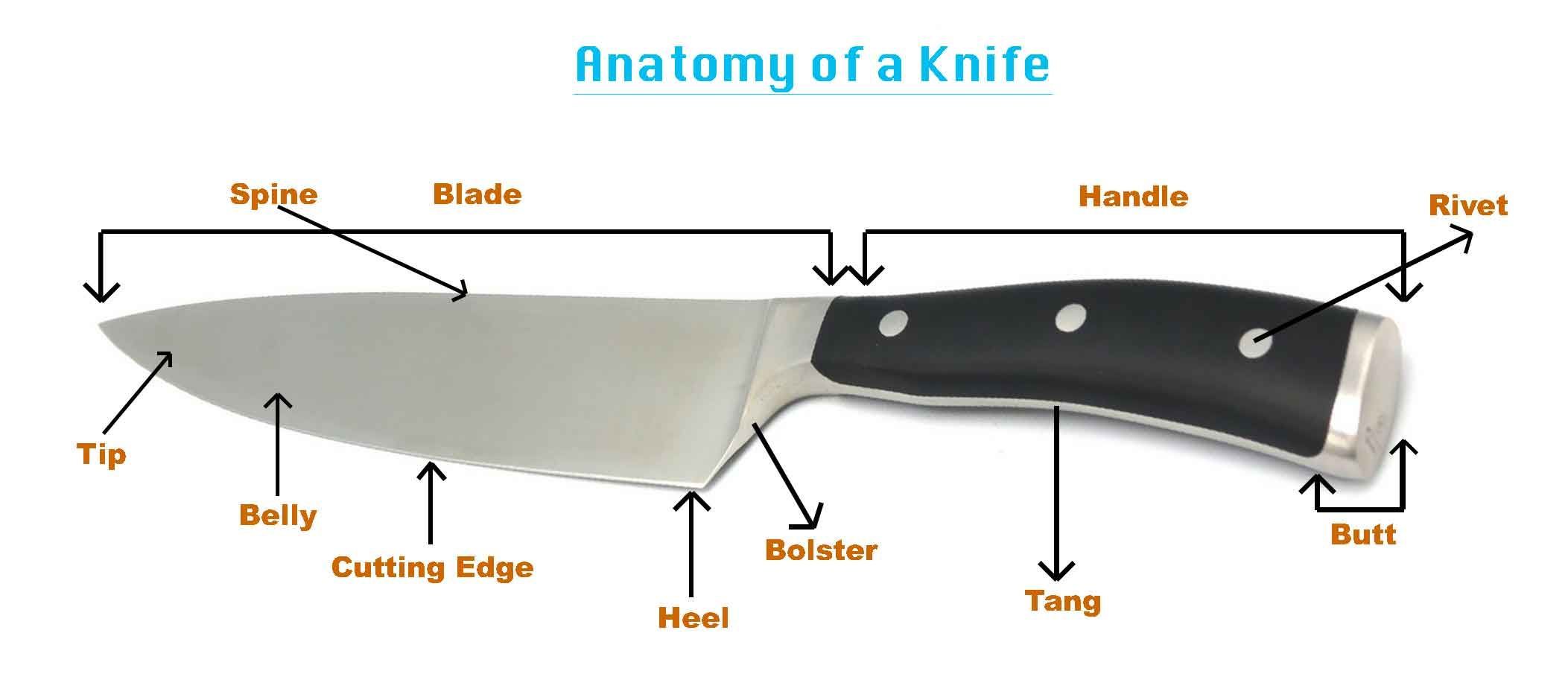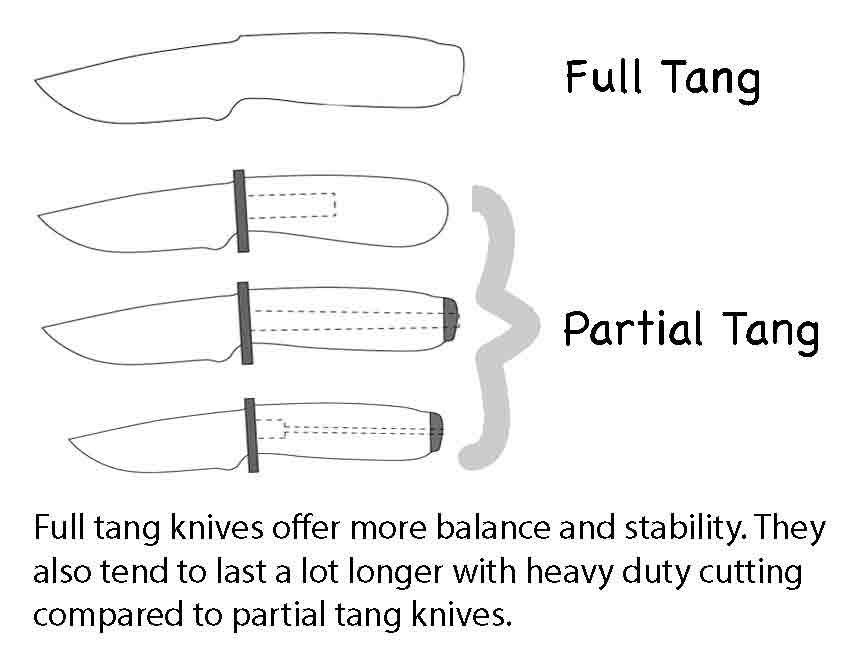Our recommendations are made independently. We may receive commissions from purchases made via our links.
Parts of a Knife – Anatomy of a Chef’s Best Friend
There are more than just a blade and a handle. The anatomy of a knife explores important parts of a knife, and what to look for when you buy one.
A knife serves as an extended part of the cook’s arm in the kitchen. Interestingly, this extension has a full body. This may come as a surprise to some, but there are no less than a dozen parts of a knife. Among others, it has its own belly, a spine, and even a butt!
Because you will always need a knife as long as you are to cook, it can only help to understand a bit about your long term companion in the kitchen.

Here we will explore the most frequently used parts of a knife- the parts that decide its quality, and should be paid the most attention to when you’re considering a purchase. Most of these parts can be found on almost every type of knives. Here we will take the chef’s knife for illustration purpose, as it’s the most common of all kitchen knives.
Parts of a Knife: The Blade
The blade is the part of the knife used for cutting, mincing, chopping, and other dividing tasks.
Modern kitchen blades are typically made of carbon steel or stainless steel. They are hardened using various techniques so that they become more durable, resistant to scratches and chipping, and at the same time, easy to sharpen. Metal blades are dominant for obvious benefits, but there are also plastic and ceramic blades. These are chosen for their affordability, immunity to rust, and the marketed no-sharpening-needed characteristics.
Economic reasons aside, it depends on their intended use that the blades of different types of knives can differ vastly in length, thickness, shape and size of their specific parts.
The tip: The front part of the blade with a point where the spine and the edge meet. It is used mainly for scoring and piercing, and is an exceptionally important feature on a paring or a boning knife. On a chef’s or a santoku knife, the tip serves as an anchor during mincing.
The belly: The part of the blade right after the tip. Knives with “curvy” bellies and small tips are usually better for slicing or chopping vegetables, as they allow quick, smooth rocking motions on the cutting board.
The cutting edge: The sharp part of the blade that is used for chopping and slicing. The edge can be smooth, as on a typical chef knife, or serrated, as on a bread knife. Smooth edges are easier to sharpen than serrated edge, as they’re more popular and most knife sharpeners are designed to handle them.
The bolster: The thick metal part in the middle, where the blade meets the handle. The bolster adds weight and balance, and is seen more often on forged knives than stamped ones. At the same time, the existence of one may also make honing the knife a bit more difficult, as it stops the blade from running all the way through a sharpener. Whether there should be a bolster or not is more of a matter of preference.
The heel: The rear end of the blade, close to where it meets the handle. This is the part that you can transfer the most force to. A sharp and strong heel can be very useful, especially on a boning knife or a chef’s knife, as you may need it to cut through tough skin or some fibrous veggie at times.
The Handle
The handle is where you’re supposed to hold the knife. Usually, it consists of two scales covering the tang, and may be fastened with rivets for extra security.
The handle can be made of wood, plastic, ivory; sometimes, it can come in one solid metal piece. The most popular material on modern kitchen knives is plastic, as the synthetic substance tends to be lighter than metal, more durable than wood, and above all, easier to mold, bend and shape for an ergonomic design.
You want a handle that feels solid, is easy to grip, and fits well in your hand. It should also have a weight that evens out that of the blade to some extent, so as to save your energy when applying a cut.
The tang: The part that extends from the blade to run into the handle of the knife. The tang may run through the whole handle (full tang), or only part of it (partial tang). Knives with full, thick tangs are more well-balanced, and are less likely to break at the handle.
If you plan to cut anything harder than tofu, always go for knives with full tangs.
The rivet: The metal pin used to fasten the scales and the tang. A good full tang knife usually comes with three rivets.
The butt: The part at the end of the handle. On bigger knives, the butt is usually covered with metal to increase balance, durability, and stability of the whole item. A large metal butt, however, may also add a bit of weight. That is why not every knife comes with one.
More on Knife Tangs
While choosing a knife, most of us think about the blade. We tend to care a lot about how sharp/thick/strong the blade is, and whether it is straight or serrated. But the tang deserves a lot a attention too.
There are a lot of different kinds of tangs, categorized mainly according to their shape. The two most popular types of tang in kitchen knives and full and partial tang.
A full tang is a tang that extends to the entire handle both in terms of length and width.
A partial tang is one that does not fully extend to the knife handle. There are various types of partial tang: the half tang which extends to half the length of the handle, the stick tang which runs all the way to the butt but is narrow, or the narrowing tang whose width reduces as it runs to the butt.

Partial tangs are usually seen on casual budget knives, as they’re smaller and require less material to made. Knives with these tangs are usually less durable – they tend to break where the tang and the blade meet. Very often, the tang and the handle fall apart after a couple years of casual use.
Full tang, meanwhile, are one of the must-have’s on brand knives. They’re more solid, heavy-weighted, and can endure more heavy-duty use. A full tang can offer better leverage and balance, thus contributing to a better cutting experience. As they require more material to make, knives with full tangs are usually more expensive.
Which kind of tang is better?
Apparently, full tangs are the way to go. They are a must if you want your knives to last for more than a few years with frequent use.
The only occasion when partial tang knives are prefered is when you just want to occasionally cut and chop tender leafy herbs or something as soft as tofu. Other than that, full tangs are always a better choice.





